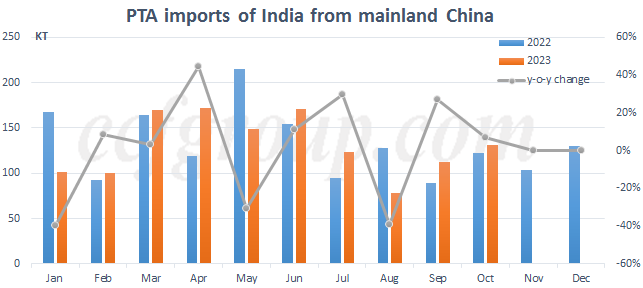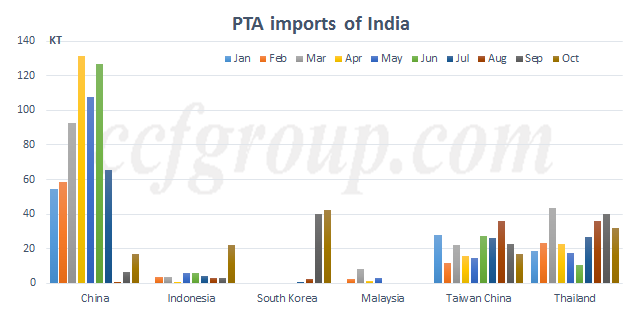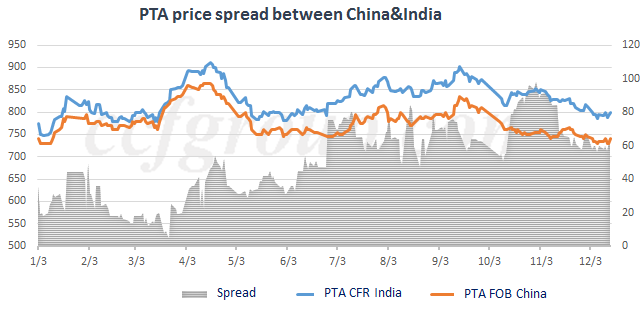Who will fill India's PTA gap?
India's polyester capacity has exceeded 10 million tons, yet its domestic PTA capacity stands at just over 6 million tons. The delayed launch of JBF's 1.25 million ton production line has prompted India to import PTA to supplement the domestic market. In 2022, India imported 1.58 million tons of PTA, which decreased by 3% in the period from January to October 2023, amounting to 1.31 million tons.

PTA imports into India require BIS certification, and the BIS certification for mainland Chinese PTA expired at the end of June, with no new certification yet in place. The current certified sources include countries and regions such as South Korea, Indonesia, Thailand, and Taiwan, China. India's monthly PTA import volumes indicates a decline in July-August due to the expiration of BIS for mainland Chinese PTA. However, there was a resurgence in PTA import volumes in September.
Looking at the source of PTA imports into India, China was the main origin in the first half of the year, with monthly import volumes ranging from 50,000 to 130,000 tons, followed by Thailand and Taiwan, China. However, Chinese exports to India decreased significantly from July, with current monthly import volumes around 20,000 tons (in term of processing trade with imported materials). In contrast, there was a noticeable increase from South Korea and Indonesia. Imports from Indonesia rose from 5,000-6,000 tons to approximately 20,000 tons, mainly through the regional circulation of PTA (China's exports to Indonesia increased from July). Imports from South Korea surged from zero to 40,000 tons (monthly exports increased, averaging 165,000 tons from January to August, and 193,000 tons in September-October), compensating for the shortage of Chinese PTA.

As India reduces its imports of PTA from mainland China, its import costs are gradually rising. Mainland China's FOB prices mostly stay around PX+$70-80/mt. Conversely, overseas prices, due to aging facilities and higher production costs, often negotiate around PX+$100/mt. Since June, the price difference between the two has been gradually widening.

Looking ahead to next year, India's polyester capacity is expected to increase, but the progress of PTA production is unclear, potentially expanding the theoretical supply-demand gap. The areas that can currently export to India, including Indonesia, Thailand, Taiwan, China, and South Korea, are not anticipated to have significant increases in production. An increase in exports to India may affect the supply in other regions. Changes in PTA regional trade flow could maintain a relatively stable demand for mainland Chinese PTA. With current higher prices in other regions exporting to India, India's polyester costs remain relatively high, possibly favoring the export of China domestic polyester products. Keep an eye on the progress of PTA and filament BIS certificate in the future.
- Top keywords
- Cotton Price
- Cotton Futures Price
- Cotton Futures
- CZCE
- PTA Futures Price
- Chemical Fiber
- Polyester Prices
- Wool price
- PTA Futures
- Shengze Silk
- China
- Yarn Price
- price
- China Textile City
- Fibre Price
- Benzene Price
- Cotton
- Index
- Cotton Index
- PTA
- fabric price
- NYMEX
- Top 10
- textile industry
- Spot Cotton
- Cotton Yarn
- Polyester Price
- Futures
- PTA Price
- cotton yarn price

